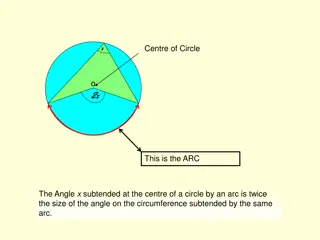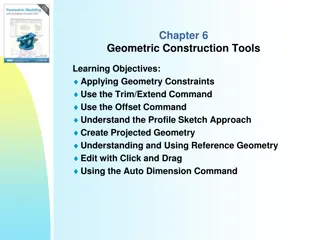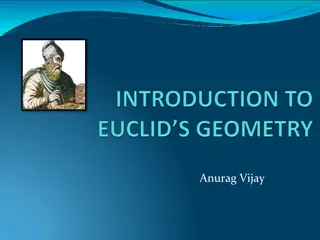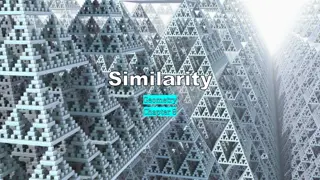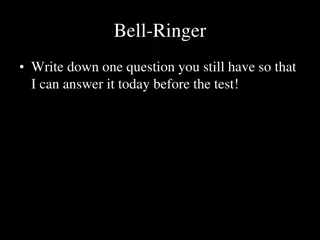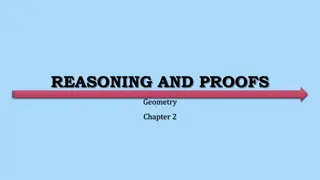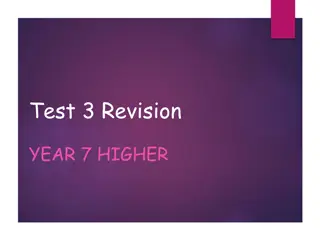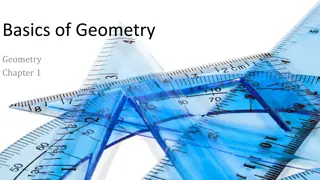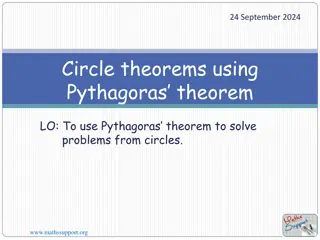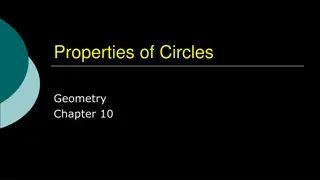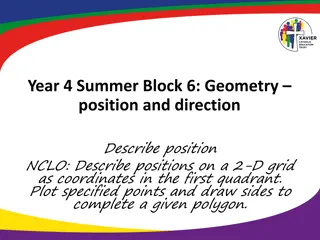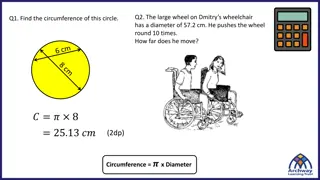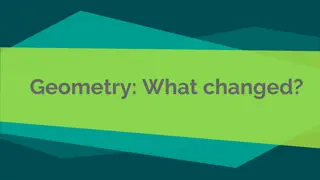Comprehensive Overview of Geometry Chapter 3 Concepts
Dive into the fundamentals of lines, planes, parallelism, and angles in Geometry Chapter 3. Explore topics such as identifying lines and planes, understanding parallel and perpendicular lines, and recognizing angle relationships formed by transversals. Discover the properties of parallel lines, transversals, interior and exterior angles, and more through clear explanations and visual aids.
Download Presentation

Please find below an Image/Link to download the presentation.
The content on the website is provided AS IS for your information and personal use only. It may not be sold, licensed, or shared on other websites without obtaining consent from the author. Download presentation by click this link. If you encounter any issues during the download, it is possible that the publisher has removed the file from their server.
E N D
Presentation Transcript
Geometry Chapter 3
This Slideshow was developed to accompany the textbook Big Ideas Geometry By Larson and Boswell 2022 K12 (National Geographic/Cengage) Some examples and diagrams are taken from the textbook. Slides created by Richard Wright, Andrews Academy rwright@andrews.edu
Objectives: By the end of the lesson, I can identify lines and planes. I can identify parallel and perpendicular lines. I can identify pairs of angles formed by transversals.
Parallel Lines || Lines that do NOT intersect and are coplanar Lines go in the same direction Skew Lines Lines that do NOT intersect and are on different planes Lines go in different directions
Name the lines through point H that appear skew to ?? Name the lines containing point H that appear parallel to ?? Name a plane that is parallel to plane CDE and contains point H
In a plane, two lines are either Parallel Intersect Parallel Postulate If there is a line and a point not on the line, then there is exactly one line through the point parallel to the given line. Perpendicular Postulate If there is a line and a point not on the line, then there is exactly one line through the point perpendicular to the given line.
Transversal Line that intersects two coplanar lines Interior angles that are between the lines 2, 3, 5, 6 1 43 2 Exterior angles that are outside of the lines 1, 4, 7, 8 6 5 8 7
Alternate interior angles interior angles on opposite sides of the transversal 2 and 5, 3 and 6 1 43 2 Alternate exterior angles exterior angles on opposite sides of the transversal 1 and 8, 4 and 7 6 5 7 8
Consecutive interior angles interior angles on the same side of the transversal 2 and 6, 3 and 5 1 43 2 Corresponding angles angles on the same location relative to the transversal 1 and 6, 2 and 7, 3 and 8, 4 and 5 6 5 7 8
Classify the pair of numbered angles 125 #2, 4, 6, 8, 9, 10, 11, 12, 14, 15, 16, 20, 21, 22, 24, 28, 32, 33, 35, 36 = 20 total
Objectives: By the end of the lesson, I can use properties of parallel lines to find angle measures. I can prove theorems about parallel lines.
Draw parallel lines on a piece of notebook paper, then draw a transversal. Use the protractor to measure all the angles. What types of angles are congruent? (corresponding, alt interior, alt exterior) How are consecutive interior angles related? (supplementary)
Corresponding Angles Postulate If 2 || lines are cut by trans., then the corrs are Alternate Interior Angles Theorem If 2 || lines are cut by trans., then the alt int are Alternate Exterior Angles Theorem If 2 || lines are cut by trans., then the alt ext are Consecutive Interior Angles Theorem If 2 || lines are cut by trans., then the cons int are supp.
If m1 = 105, find m4, m5, and m8. Tell which postulate or theorem you use in each case If m 3 = 68 and m 8 = (2x + 4) , what is the value of x?
Prove that if 2 || lines are cut by a trans, then the ext angles on the same side of the trans are supp. Given: p || q Prove: 1 and 2 are supp. Statements 1 q 3 p 2 Reasons
131 #2, 4, 5, 6, 8, 10, 12, 14, 15, 18, 20, 22, 23, 24, 26, 29, 30, 32, 33, 38 = 20 total
Objectives: By the end of the lesson, I can use theorems to identify parallel lines. I can prove theorems about identifying parallel lines.
Corresponding Angles Converse If 2 lines are cut by trans. so the corrs are , then the lines are ||. Alternate Interior Angles Converse If 2 lines are cut by trans. so the alt int are , then the lines are ||. Alternate Exterior Angles Converse If 2 lines are cut by trans. so the alt ext are , then the lines are ||. Consecutive Interior Angles Converse If 2 lines are cut by trans. so the cons int are supp., then the lines are ||.
Is there enough information to conclude that m || n? Can you prove that the lines are parallel? Explain. m 1 + m 2 = 180
Transitive Property of Parallel Lines If two lines are parallel to the same line, then they are parallel to each other. Paragraph proofs The proof is written in sentences. Still need to have the statements and reasons.
Write a paragraph proof to prove that if 2 lines are cut by a trans. so that the alt int s are , then the lines are ||. Given: 4 5 Prove: g || h
If you use the diagram at the right to prove the Alternate Exterior Angles Converse, what GIVEN and PROVE statements would you use? 138 #2, 4, 6, 10, 12, 14, 16, 20, 22, 24, 26, 28, 30, 32, 35, 39, 41, 44, 45, 49 = 20 total
Objectives: By the end of the lesson, I can find the distance from a point to a line. I can prove theorems about perpendicular lines.
Distance From point to line: length of segment from point and to line Between two || lines: length of segment to both lines
Linear Pair Perpendicular Theorem If two lines intersect to form a linear pair of congruent angles, then the lines are perpendicular.
Perpendicular Transversal Theorem If a trans. is to 1 of 2 || lines, then it is to the other. Lines to a Transversal Theorem In a plane, if 2 lines are to the same line, then they are || to each other.
Prove the Perpendicular Transversal Theorem using the diagram and the Alternate Interior Angles Theorem. Given: h || k, j h Prove: j k Statements Reasons
Is b || a? Is b c? 146 #2, 10, 12, 14, 16, 18, 20, 21, 24, 26, 34, 40, 42, 45, 46 = 15 total
Objectives: By the end of the lesson, I can partition directed line segments using slope. I can use slopes to identify parallel and perpendicular lines.
Partitioning a Directed Line Segment Segment from A to B Want the ratio of AP to PB to be something like 3 to 2 That means there are 3 + 2 = 5 pieces Point P is 3 Find the rise and run Multiply the rise and run by the fraction 3 add to point A The result is the coordinates of P 5 of the way from A 5 and
Find the coordinates of point F along the directed line segment CD so that the ratio of CF to FD is 3 to 5.
Slope =rise run (x2, y2) ? =?2 ?1 ?2 ?1 rise run (x1, y1)
Positive Slope Rises Zero Slope Horizontal 0 + Negative Slope Falls No No Slope (Undefined) Vertical There s No Slope to stand on.
Slopes of Parallel Lines In a coordinate plane, 2 nonvertical lines are parallel iff they have the same slope. And, any 2 vertical lines are parallel. m1 = 2; m2 = 2 Slopes of Perpendicular Lines In a coordinate plane, 2 nonvertical lines are perpendicular iff the products of their slopes is -1. Or, Slopes are negative reciprocals. And, horizontal lines are perpendicular to vertical lines m1 = 2; m2 = -
Tell whether the lines are parallel, perpendicular, or neither. Line 1: through ( 2, 8) and (2, 4) Line 2: through ( 5, 1) and ( 2, 2) 154 #1, 2, 3, 4, 5, 6, 7, 8, 9, 10, 53, 54, 57 = 13 total
Objectives: By the end of the lesson, I can write equations of parallel and perpendicular lines. I can find the distance from a point to a line.
Slope-intercept form of a line y = mx + b m = slope b = y-intercept To write equations of lines using slope-intercept form Find the slope Find the y-intercept It is given or, Plug the slope and a point into y = mx + b and solve for b Write the equation of the line by plugging in m and b into y = mx + b
Write an equation of the line that passes through (1, 5) and is parallel to the line with the equation y = 3x 5.
Write an equation of the line perpendicular to the line in the graph and passing through (3, 1).
Find the distance from a point to a line Find the equation of the line perpendicular to the given line and passing through the point. Use a graph or system of equations to find where the lines intersect. Find the distance between the given point and the point of intersection.
Find the distance from the point (6, 2) to the line y = 2x 4. 154 #12, 14, 16, 18, 20, 22, 24, 36, 38, 46, 62, 64 = 12 total

 undefined
undefined


